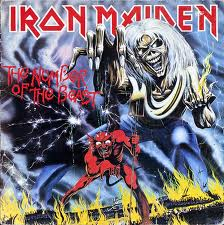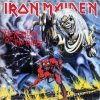 Originally published by L.S. Media. March 25th 2012
Originally published by L.S. Media. March 25th 2012
This week saw the 30th anniversary of one the seminal albums of what became known as the New Wave of British Heavy Metal era. Iron Maiden’s The Number of The Beastnot only stands out as one of the best by the definitive Metal bands from Great Britain but also one of the best of the whole Heavy Metal genre.
Released on the 22nd March 1982, The Number of the Best ran at breakneck speed over the next 40 odd minutes, produced with an absolute sense of dedication by Martin Birch. Alongside Birch, the band that had been guided by main songwriter and bassist Steve Harris in the group’s formative years and through the first two albums, the self- titled Iron Maiden and Killers became one of the greatest and incredible metal bands that, with just a minor blip in the late 90’s, has seen them dominate and sell millions of records, unheard of for a metal band at the time.
It may come as a surprise that the vocalist Bruce Dickinson played no part in the band’s first two albums. That was left to original lead man Paul Di’Anno whose gravelly voice and stage demeanor suited the first two offerings but by the time The Number of The Beast was ready to be conceived the decision to dispense with Di’ Anno had been taken and the former Samson vocalist Bruce Dickinson coming on board. There are few moments in music that hang and change on a pivotal moment, think of Freddie Mercury’s show stopping turn with Queen at 1985’s Live Aid concert, the moment where Bruce Springsteen was identified as the future of Rock and Roll by a journalist, Mike Oldfield’s determination to go through the personal hell of producing Tubular Bells and you’re close to how the new sound of the revitalised Iron Maiden sounded. The album’s producer, Martin Birch, remarked, “I simply didn’t think (former vocalist Paul Di’Anno) was capable of handling lead vocals on some of the quite complicated directions I knew Steve wanted to explore… when Bruce joined, it opened up the possibilities for the new album tremendously.”
The new album was preceded by a single release, the dynamic and long standing show song of Run to the Hills. If anything was going to show that the band could handle the change in personnel and take the next stage full on. It was a difficult birth as for the first time the band started a new album with no work started; a band that was going through evolution and a ravenous public ready for the next stage of the hopeful rise of the metal group.
Run to the Hills allayed any fears, Bruce Dickinson’s incredible voice suited the new material and overnight it was clear that Iron Maiden were going to be a force for a long time to come. This was helped by the artistic contribution of Derek Riggs. The artist was at the forefront of the visual side of the bands mass appeal for many years, the representation of the band’s permanent mascot, Eddie being bigger and more controlling than the Devil is a powerful suggestion and in some parts of the United States where Christian fundamentalism reigns unchecked, the album cover caused unwanted and unneeded controversy. Not that Iron Maiden’s mascot or his creator Derek Riggs had been far from controversy in the first three albums. On the cover for the song Women in Uniform, certain groups took exception of the idea of Eddie walking along with a nurse and a school girl, arm in arm whilst an awaiting former Prime Minister Margaret Thatcher waited with a machine gun to shoot Eddie. No matter who it offended, it is a class piece of music art that summed up the times and proves beyond measure that something has been lost with the mass departure of vinyl from the record buying public’s nature.
The music itself was fresh and even 30 years after its first introduction still sounds extreme and phenomenal. It stands alongside Seventh Son of a Seventh Son as one of the finest moments in the bands long and barely blemished history.
There are few albums where off the top of your head you can say there are at least four songs that give such vivid imagery and powerful lyric based drama. In this album every single song is a gem of the genre. In Hallowed be Thy Name, 22 Acacia Avenue, The loving ode to Patrick MaGoohan’s surreal T.V. programme The Prisoner and the title track The Number of the Beast, Iron Maiden hit pure metal gold.
Thirty years on, The Number of the Beast remains a highlight, a utopia of Heavy Metal music and a point in which a band became truly global. It also saw long standing drummer Clive Burr’s final appearance with the metal masters due to illness. The rotation would go on over the years but Dave Murray, Steve Harris, Adrian Smith, Bruce Dickinson and Clive Burr would for a brief moment be the most incredible and musically dominant men on the planet.
Ian D. Hall
